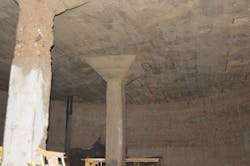A New Lease on Life
In 1912, the decision was made by Ardmore, Okla., oilman Jake Hamon and circus magnate John Ringling to build a railroad from Ardmore to Healdton, Okla. Shortly after the railroad began functioning, it was decided that a depot was needed halfway between the two cities. In 1914, the depot was established into a new town site that was named Wilson (in honor of Ringling’s secretary, Charles Wilson). By 1918, the old Wilson had disappeared, and on August 5, 1918, Oklahoma governor R. L. Williams declared a “New Wilson.”
At around the time Wilson was founded, oil was discovered in the region. By the end of 1914, it was estimated that Wilson had more than 2,000 residents. By 1918, there were three oil refineries, three cotton gins, more than 5,000 residents and everything that went with a booming oilfield town. During this time, Wilson served as the trading center for many smaller communities in the region, but with the depression days of the 1930s and World War II, many of these communities ceased to exist. The railroad closed in 1976. Today, Wilson’s population has stabilized at approximately 1,700 residents.
Problem
Wilson’s potable water is supplied from wells and stored in four 80,000-gal concrete storage tanks that were built in the 1930s. Two of these tanks were in extremely poor condition, with cracks and leaks caused by the deterioration of the concrete, exposing the rebar. One of these tanks was leaking so badly that it was taken out of commission, which required the town to spend $4,000 per month to purchase water to meet its demand.
The town council needed to make a quick decision about whether to replace these clear well tanks, which would cost more than $1 million, or find a way to quickly fix them so they could continue supplying safe, clean drinking water to the town.
WT Energy Services evaluated this challenge and recommended rehabilitating these clear well tanks with Raven AquataFlex 510, a 100% solids NSF ANSI61 pure polyurea lining for potable water.
Challenges and Issues
The inside walls were covered with a thick layer of calcite (calcium carbonate) that had built up over the last 80 years due to the hard well water. This had to be removed, along with any loose concrete, before the rehabilitation process could begin.
Another challenge was the extremely cold winter weather that occurred during the project, with temperatures fluctuating between 20 and 50°F. This required a coating system that was engineered to both be applied and cure in a cold environment.
Solutions and Process
The applicator prepared the surface by grit blasting to remove calcite buildup and loose concrete. The walls were then repaired using a cementitious material to rebuild the extensive deterioration.
Due to the extreme weather conditions during the project, the Raven 171FS primer was recommended as the best option for the cold conditions to reduce out-gassing. The 171FS is a 100% solids, fast-curing concrete epoxy primer with little to no blushing.
The final step was to apply an 80 to 100-mil topcoat of the AquataFlex 510. As a quality control check to assure a monolithic lining, WT Energy performed a spark test on the structure and made necessary repairs.
The project was completed on time and within budget.
“The city of Wilson needed to find a way to repair the water tanks or build new ones,” said Buddy Way, president of WT Energy. “We were able to provide a high-quality, cost-effective engineered solution to provide a long-term fix of the existing tanks for the city. It was a big success for everyone involved.”
Benefits
The cost of replacing the underground water storage tanks would have been approximately $1.4 million.
“Thanks to WT Energy and Raven Lining Systems, the City of Wilson was able to repair the tanks for $140,000, which was a $1.26 million savings for the city,” said Wilson Mayor Frank Schaaf.
On top of this capital savings, the town will be able to realize an additional $480,000 in savings over the next ten years by not having to purchase as much water from a neighboring town to meet its potable water demand.
